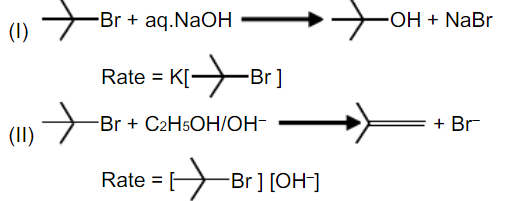trans Dimethyl octene exists in two diasteromer and .

Which statement is true about and ?
is optically active and is not.
is optically active and is not.
Both are optically active.
Both are optically inactive due to the presence of centre of symmetry.
The correct Answer is:a
(II) is O.I.A.(meso) due to centre of symmetry.

Topper's Solved these Questions
- ALKENES AND ALKADIENESBOOK - CENGAGE CHEMISTRY ENGLISHCHAPTER - ALKENES AND ALKADIENESEXERCISE - Archives(ASSERTION-REASIOING)
4 Videos
- ALKENES AND ALKADIENESBOOK - CENGAGE CHEMISTRY ENGLISHCHAPTER - ALKENES AND ALKADIENESEXERCISE - Fill in the Blanks
3 Videos
- ALKENES AND ALKADIENESBOOK - CENGAGE CHEMISTRY ENGLISHCHAPTER - ALKENES AND ALKADIENESEXERCISE - Multiple Correct Answer Type
41 Videos
- ALKANES AND CYCLOALKANESBOOK - CENGAGE CHEMISTRY ENGLISHCHAPTER - ALKANES AND CYCLOALKANESEXERCISE - Archives
13 Videos
- ALKYNESBOOK - CENGAGE CHEMISTRY ENGLISHCHAPTER - ALKYNESEXERCISE - Exercises (Archives - Analytical and Desriptive Type)
4 Videos
Similar Questions
If the stereochemistry about the double bond in (A) is trans, two diastereomers (I) and (II) exist as shown in Question.
Which statement is correct ?
View Solution
Choose the correct statement about I, II and III.
View Solution
Correct statement regarding these two reaction I and II
View SolutionWhich of these statements about [Co(CN)6]3− is true?
View SolutionWhich of the statement true ?
6:4.5::4.8:3.6
View SolutionSolve:
(i) 8! (ii) 4! - 3!
View Solution(a) Statement I is true, Statement II is true , Statement II is a correct explanation for statement I.
(b) Statement I is true, Statement II is true, Statement II is not a correct explanation for Statement I.
(C) Statement I is true, Statement II is false.
(D) Statement I is false , Statement II is true.
Statement I through the point (π,π+1),π<2, there cannot be more than one normal to the parabola y2=4ax . Statement II The point (π,π+1) cannot lie inside the parabola y2=4ax .
View SolutionString I and II have identical and linear mass densities, but string I is under greater tension than string II. The accompanying figure shows four different situations, A to D, in which standing wave patterns exist on the two strings. In which situation it is possible that strings I and II are oscillating at the same resonant frequency ?
View SolutionThe electronic configuration of four elements are:
(I) [Kr]5s1
(II) [Rn]5f146d17s2
(III) [Ar]3d104s24p5
(IV) [Ar]3d64s2
Consider the following statements:
(I I shows variable oxidation state
(ii) II is a d-block element
(iii) The compound formed between I and III is covalent
(iv) IV shows single oxidation state
which statement is true (T) or false (F)?
View SolutionA.Statement I is True: Statement II is True; Statement II is a correct explanation for statement I B.Statement I is true, Statement II is true; Statement II not a correct explanation for statement I. C.Statement I is true, statement II is false D.Statement I is false, statement II is true Statement I: coses−1(cosec95)=π−95. because Statement II: cosec−1(cosecx)=π−x: ∀x∈[π2,3π2]−{π} a.A b. B c. C d. D
View Solution
